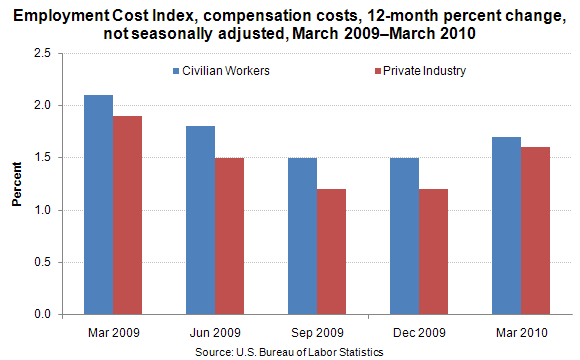Chart: Employee compensation costs in March
Tags: talent management, business management
Compensation costs increased for both civilian workers and private industry workers in March 2010 on a 12-month, not seasonally adjusted basis, the U.S. Department of Labor's Bureau of Labor Statistics reported. Wages and salaries make up about 70 percent of compensation costs, while benefits make up the remaining 30 percent.
Compensation costs for civilian workers increased 1.7 percent, not seasonally adjusted, for the 12-month period ending March 2010. This was smaller than the 2.1-percent increase for the 12-month period ending in March 2009.
Compensation costs for private industry workers increased 1.6 percent for the same period, not seasonally adjusted, compared to 1.9 percent for the 12-month period ending March 2009. Employer costs for health benefits increased 4.5 percent for the 12-month period ending March 2010. In March 2009, the 12-month percent change was 4.6 percent.
This data is from the BLS Employment Cost Trends program. To learn more, see "Employment Cost Index – March 2010" (HTML) (PDF), news release USDL-10-0535. The Employment Cost Index (ECI) measures the change in the cost of labor, free from the influence of employment shifts among occupations and industries. Benefits costs include paid leave, supplemental pay, insurance benefits, retirement and savings, and legally required benefits. Paid leave benefit costs include employer costs for vacations, holidays, sick leave, and personal leave.
